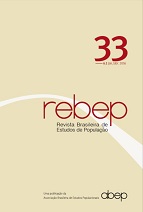Urban agglomerations and demographic mobility: the case of the metropolitan region of Campinas, Brazil
DOI:
https://doi.org/10.20947/S0102-309820160006Keywords:
Internal migration, Intrametropolitan migration, Residential mobility, Motivation for migration, Metropolitan Area of Campinas-BrazilAbstract
This paper analyzes the complexities of migratory dynamics in a large urban agglomeration. This complexity can be seen both in the variety of movements and in the individual and collective characteristics of the migrants themselves, as well as in the structural elements that affect them. Using data from a household survey in the metropolitan area of Campinas (MRC) taken in 2007 and from the 2010 Demographic Census, it is examined several dimensions of residential mobility in the MRC, especially in terms of the characteristics and motivations of the actors involved. Despite the reduction of external migration into the region, a significant potential of internal population redistribution, stemming from the mobility of people within the MRC, is registered.
Moreover, contrary to other metropolitan areas, notable migration from outside the region still flows directly into the periphery within the MRC. Analysis of the demographic and socioeconomic characteristics of movers (and non-movers) suggests coherence between what would be expected to observe for a migration conditioned by economic factors and by the position occupied by the RMC in the national and São Paulo state scenarios, as well as by the region´s process of production of space. The selectivity of migrants, in general, and of intrametropolitan migrants, in particular, suggests different motivations according to which housing issue are a significant, though not dominant, issue. The study also shows that, contrary to what was observed in the past, the metropolitan periphery has been diversifying and incorporating more high-income individuals and families.
DOI http://dx.doi.org/10.20947/S0102-309820160006
Downloads
Downloads
Published
How to Cite
Issue
Section
License
Papers published in Rebep are original and protected under the Creative Commons attribution-type license (CC-BY). This license allows you to reuse publications in whole or in part for any purpose, free of charge, even for commercial purposes. Any person or institution can copy, distribute or reuse the content, as long as the author and the original source are properly mentioned.

